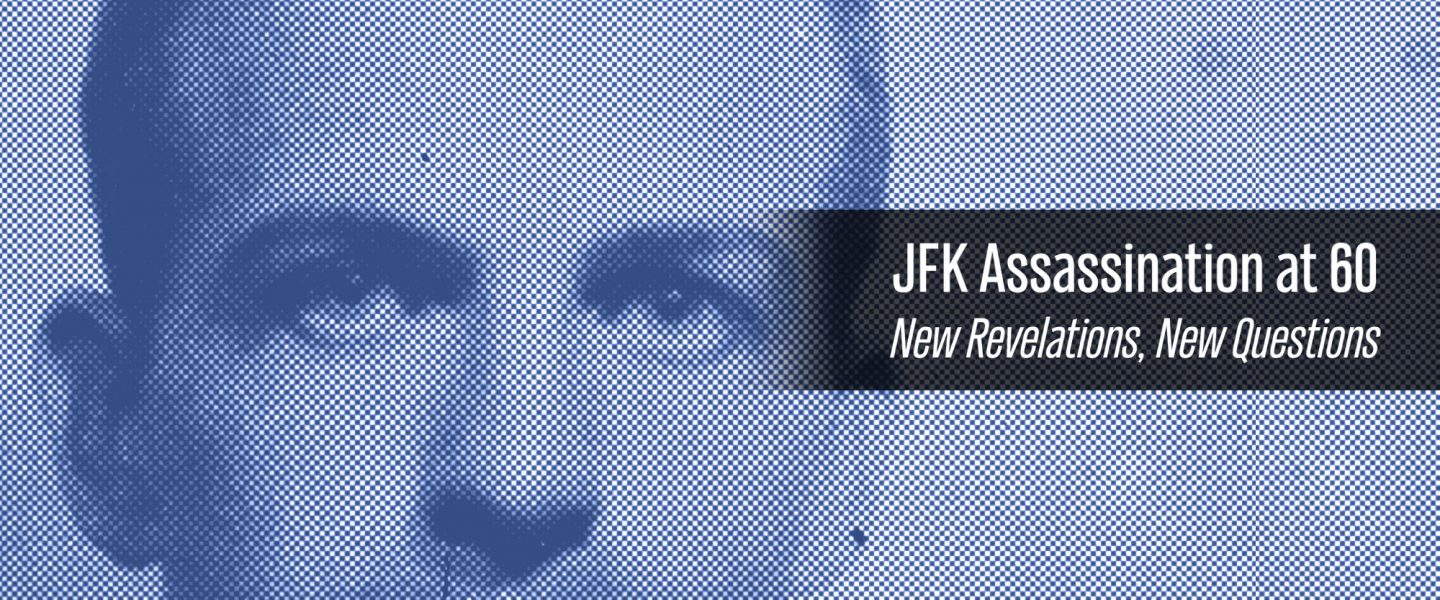He was used, then discarded. And for what?
|
Listen To This Story
|
Four years before Lee Harvey Oswald became infamous as President John F. Kennedy’s alleged assassin, he played an equally unlikely role as a teenage defector to the Soviet Union. The official story will have you believe the defection was evidence of his communist leanings and his growing disillusionment with the US which would eventually — on November 22, 1963 — turn violent. The facts of his defection tell a very different story, that of a high-value and unusually experienced young American intelligence operative on a very sensitive mission.
The Difficulties of Defection
It’s September, 1959. You’re 19 years old, fresh out of the Marines on an emergency discharge to care for your ailing mother, but then for some very compelling reasons (whatever they are), you decide you must defect to the Soviet Union ASAP.
In 1959, it’s not difficult to migrate to the socialist side of the Iron Curtain. Berlin is still an open city. You can stroll over to the east and present yourself as a defector to the DDR Volkspolizei or even directly to the Russian soldiers stationed there. The only problem is that doing so is not going to get you to the USSR if that is your goal.
And that is your goal: USSR or bust.
The defector pathway eastward was established in the early 1950s while Austria and Germany were still under occupation. Defectors were a mixed bag of opportunists, miscreants, and malcontents: GIs fleeing prosecution for criminal activity or past leftist political affiliations, couples in interracial or otherwise forbidden relationships, economic migrants, and the occasional Marxist ideologue.
This is how it went: A defector fled to the Eastern Bloc and requested asylum from officials. After the police or army interrogated them for a couple of days, they’d be sent to a village in East Germany to live among their fellow defectors, taught a useful trade, and then resettled somewhere in the DDR or maybe Bratislava or Brno or some other satellite city a safe distance from the Russian border.
Although the defectors themselves didn’t know what was going to happen, the US intelligence agencies were aware of the typical route for these legitimate defectors. Aware, because they were grappling with the difficulty of building a human intelligence infrastructure inside the USSR.
The CIA, established in 1947, is a Cold War kid. Unlike Great Britain’s MI6 (founded in 1909), the US didn’t have a preexisting intel presence in czarist or Bolshevik Russia. That meant that US intelligence usually had to rely on their British counterparts for on-the-ground operations. The formula was simple: The US paid the bills and MI6 provided human resources. But by the mid-1950s, after high-ranking British diplomats and officials were outed as KGB moles in the Cambridge Five spy scandal, the CIA knew it had to move to a more independent model.
The CIA also knew this: To place an intelligence asset in the USSR, you had to start from inside the USSR. To this end, as a longtime military intelligence officer put it, it was “not an unusual operation” to set up a “fake defection.”
However, that presented some bureaucratic considerations. To get into Russia, one needed a visa, either for business or tourism. Business visas required a valid business purpose, an impossibility for an unemployed teenage ex-Marine. Tourist visas were available from several Soviet consulates in Europe but required a processing time of seven to 14 days or more.
The only exception to this was the less-frequented consulate in Helsinki; an official there could fulfill a tourist visa request in 24 hours or less.
You disembark your freighter in Le Havre and make a beeline for London. A teenager on his first trip to Europe. A man in a hurry. Your next move somehow avoids generating any official travel records or witnesses but sure enough, you resurface within 24 hours. In Helsinki.
In 1959, it’s deep insider knowledge that the Soviet consulate in Helsinki is the place for a quickie USSR visa. A series of CIA and State Department memos in September and October of 1959 confirms this very detail — that a US citizen who purchases a tourist package to the USSR can get a visa in as little as 24 hours from the Soviet consulate in Helsinki. But this isn’t public knowledge at the time or for the next 15 years, because those documents won’t begin to be declassified until 1978.
So how is it that in 1959 an unemployed American teenager on his first trip to Europe knows to make his way to Helsinki for a quick Soviet visa?
October 31, 1959. Halloween. The US Embassy, Moscow. Shortly before closing time, you make your way to the lobby, asking to speak to a consular official. It’s Saturday hours, the offices are quiet. You want to announce your intention to defect, a most unusual step for a defector, but yours is a life full of unusual steps.
The setting at the embassy is unfamiliar but the people around you are from the same subset of Americans that you’ve been associating with since the age of 15 and perhaps even earlier: specifically, intelligence assets. Your personal Venn diagram overlaps with these types wherever you go in the world: New Orleans, Texas, Japan, California, and now the USSR. Always within an arm’s reach of US intelligence, just as you are as you sit in the waiting room next to Ned Keenan, a graduate student and future Harvard dean who is currently studying in Leningrad.
Your name is called. The man across the desk was officially CIA a few years back, might be CIA under State Department cover now. Who knows? Whatever the truth is, his career is murky enough for him to prevaricate about it to a congressional committee 15 years later, a situation that the committee deems “extremely troubling.”
But today, you trust him with what you have to say about your intended defection. He reports later that it sounded like a “preplanned speech.” Maybe so. But still, he listens and tries to reason with you. He’s unmoved by your stated intention to offer military secrets to the Russians, even though this should result in your being detained and charged with crimes. Maybe you remind him of the university students he recruited for a CIA informant program a few years ago. Students like Ned Keenan, who you saw in the lobby. Young Mr. Keenan will go on to meet with sources in Russia, be expelled from the country, and later be reported in Russian media as having worked for the CIA.
The consular official takes your passport from you for safekeeping or something. Apparently, you can’t renounce your citizenship on Saturdays; you’ll have to return another day to fill out the proper forms. Which you don’t do but at least you know where your passport is and exactly who is holding on to it should you ever decide to return to the US. Which you will do in two years’ time.
The consular official’s assistant listens in on the whole exchange and then appoints himself unofficial press agent, tipping off favored reporters that this young Marxist defector might make a good story for the folks back home. One of those reporters took up journalism only after her job application had been rejected by the CIA. Now she’s in Moscow, taking story tips from US consular officials with intelligence ties.
You tell your plaintive but not-very-accurate life story to the US media. It’s the compelling tale of a poor boy from Fort Worth who’s seen the ravages of capitalism firsthand in his single mother’s quest to support her sons with minimum wage jobs. Never mind that you’re not really from Fort Worth or that your extended family in your actual hometown of New Orleans has longstanding ties to intelligence agencies, organized crime, and influential citizens. Or that somehow, by age 19, you’re conversant in German, Spanish, and Russian.
While other defectors are publicly denounced as “mentally ill” or “homosexuals” or even “bestialists” by the US government, Lee Harvey Oswald is just a Marxist misfit kid. It makes a fleetingly sensational local story in 1959 but it makes a globally sensational story in November 1963 when he’s arrested in Dallas for killing the president of the United States.
You say “They’ve taken me in because of the fact that I lived in the Soviet Union.” You say “I’m just a patsy.” Not one of your well-connected friends steps forward to defend you even though they know you didn’t do this.
You deny all charges but you don’t get to clear your name before you’re murdered three days later. You die as you lived, within arm’s reach of US intelligence.
About the JFK Assassination Series
This series was inspired by an ongoing project of WhoWhatWhy Founder and Editor-in-Chief Russ Baker to produce a definitive, meticulous, book-length investigation of Kennedy’s death.
Click here for the introduction to the series. To see all the articles in the series, click here.
If you have information to bring to our attention about any aspect of the JFK assassination — or are with the media and interested in covering or reproducing our work or inviting Mr. Baker to appear on a program — please click here.
If you would like to be on a mailing list to receive news of the book, click here.


